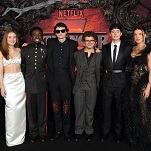Dollhouse: "Belonging"

Programming note: As many of you have probably heard here or elsewhere, FOX has decided to pull Dollhouse from its November sweeps line-up, replacing it with reruns of House and Bones instead. It’s a serious bummer, but the numbers game is what sweeps month is all about, and I trust the network was being prudent. After this week’s episode, we won’t see another one until December 4th, when we’ll see a whole bunch: The plan is to burn off two episodes a week for three weeks. That will bring the overall total to 10 episodes aired, and there’s no word yet on when or whether FOX will unveil the remaining three. Of course, I intend to cover the lot of them for you, but the two-a-night schedule will likely result in shorter, punchier reviews of each (a la Noel’s Buffy blog) rather than my usual long-windedness. Might be beneficial to everyone, now that I think about it.
In the meantime, there’s “Belonging,” which after the stellar “Belle Chose” from two weeks ago, finds the show hitting its stride. (Incidentally, if you want to read an entertaining account of the perils of being a Dollhouse fan, I recommend Daniel Feinberg’s piece “The Critic Who Cried Dollhouse” over at HitFix. I like the show better than he does overall, but know the experience of recommending it to friends with caveats aplenty.) Though loaded with well-orchestrated twists and turns—it was scripted by Jed Whedon and Maurissa Tancharoen, the writing team responsible for “Epitaph One”—the episode goes deep into the fundamental ickiness of the Dollhouse itself and the complicated people who operate it and are offered up for hire. I know some have expressed frustration about all these slippery identities and nobody on Dollhouse being as they seem (hello, Zack Handlen) but I think episodes like “Belonging” (and certainly “Epitaph One”) go a long way toward expressing the tragic insidiousness of a place where everyone is a victim of some kind or another.
Specifically, “Belonging” addresses the niggling little issue of actives being pimped out regularly to clients. Following through on last season’s “Needs,” which suggested that Sierra was essentially sold to the Dollhouse like a slave rather than volunteering, the episode shows off Dichan Lachman’s versatility just as powerfully as “Belle Chose” did Enver Gjokai’s Victor two weeks ago. We meet her first as a craftswoman named Priya on Venice Beach, where she’s approached by Nolan, a handsome dude who goes to great lengths to seduce her: Giving her (kinda crappy) paintings a gallery show and hiring two other dolls (Victor and Echo) to talk him up, but when he finally makes a clumsy, then violent romantic overture, she’s having none of it. Nolan then does what might be called turning her out: He drugs her, makes others believe she’s a paranoid schizophrenic, has her institutionalized, and uses his connections with Dollhouse to “help” her by making her a doll. Then he can possess her as any heartsick repeat client would.
With a little prodding from Echo, who picks up on the subtly disturbed paintings Sierra produces when she’s at rest, Topher figures out what happens. And you know what? It shocks him to the core. As I’ve written time and again in late Season One and early Season Two, Topher has evolved from irritating gadfly to maybe the MVP of the series, and that dramatic improvement has dovetailed with his transformation from smug, amoral, know-it-all science whiz to a tortured (yet still mordantly witty) genius who has finally grown a conscience. His scenes with Adelle (Olivia Williams, who has been brilliant from the start), after they realize what really happened to Sierra, underline just how little control even the people in charge of day-to-day operations ultimately exert over the place. It’s amoral power brokers like Keith Carradine’s character who really run the show—not to mention extravagantly wealthy sleazebags like Nolan, who get what they want.







































